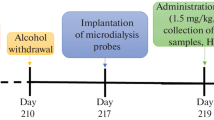Summary
Harman occurs in rat brain, with the highest concentration in the cerebellum and the lowest in the striatum. 2 g/kg ethanol were ineffective with respect to the concentration of harman in the brain whereas 5 g/kg ethanol caused a time-dependent increase in the cerebral cortex as well as the cerebellum. A toxic dose (8 g/kg) of ethanol elicited no change of harman in the brain 3 h following the application. The rise in the harman concentration in the brain did not correlate with the increase of acetaldehyde in the blood after treatment with ethanol suggesting that several mechanisms are involved in the changes of the levels of harman. In subchronic experiments rats were treated with ethanol over a period of 5 or 6 days. Harman increased in the brain whereby the effect seemed to be more pronounced in the cerebellum than in the cerebral cortex. The concentration tended to increase over time and reached control levels again during withdrawal. The time course of the excretion of harman into the urine was similar to that of the brain in that it increased continuously during the period of ethanol treatment and reached control levels again during with-drawal.
Similar content being viewed by others
References
Battey LL, Heyman A, Patterson J Jr (1953) Effects of ethyl alcohol on cerebral blood flow and metabolism. J Am Med Assn 152:6–10
Baumann P, Rivier L, Perey M (1983) Assay of tryptophan and related compounds such as norharman derivatives by gas chromatography — mass spectrometry in plasma. In: Frigerio A (ed) Recent developments in mass spectrometry in biochemistry, medicine and environmental research. Elsevier, Amsterdam, pp 7–18
Bidder TG, Shoemaker DW, Boettger HG, Evans M, Cummins JT (1979) Harman in human platelets. Life Sci 25:157–164
Dolzhenko AT, Komissarov IV, Serdyuk SE (1982) Harmane and 3-methylharmane as blockators of presynaptic alpha2-adrenoceptors. Abstract 21, Physiology and Pharmacology of smooth muscle, Varna, Bulgaria
Eriksson CJP, Sippel H, Forsander O (1977) The determination of acetaldehyde in biological samples by head-space gas chromatography. Anal Biochem 80:116–124
Eriksson CJP (1980) Metabolism of acetaldehyde in the liver and gastrointestinal tract. INSERM 95:111–130
Freund KJ (1975) Zum Verhalten des Alkoholmetaboliten Acetaldehyd im Blut. Blutalkohol 12:389–392
Gaines K, Salhany J, Tuma D, Sorrell M (1977) Reaction of acetaldehyde with human erythrocyte membrane proteins. FEBS Letters 75:115–119
Goodwin DW, Dowd CP, Guze SB (1971) Biphasic and reversible adaptation of goldfish to alcohol. Nature 232:654–655
Knott PJ, Marsden CA, Curzon G (1974) Comparative studies of brain 5-hydroxytryptamine and tryptamine. Adv Biochem Psychopharmacol 11:109–114
Lüben V, Post D, Grüner O (1972) Gaschromatographische Untersuchungen zum Vorkommen des Acetaldehyds in Blutproben. Blutalkohol 9:465–472
Machata G, Prokop L (1971) Alkoholabbau and Acetaldehyd. Blutalkohol 8:281–284
Majchrowicz E (1975) Induction of physical dependence upon ethanol and the associated behavioral changes in rats. Psychopharmacologia (Berlin) 43:245–254
Naranjo C (1979) Psychotropic properties of the harmala alkaloids. In: Efron DH, Holmstedt B, Kline NS, (eds) Ethnopharmacologic search for psychoactive drugs. Raven Press, New York, pp 385–391
Philips SR, Durden DA, Boulton AA (1974) Identification and distribution of tryptamine in the rat. Can J Biochem 52:447–451
Pohorecky LA (1977) Biphasic action of ethanol. Biobehav Rev 1:231–240
Poindexter EH, Carpenter RD (1962) The isolation of harmane and norharmane from tobacco and cigarette smoke. Phytochem 1:215–221
Rommelspacher H, Strauss S, Lindemann J (1980a) Excretion of tetrahydroharmane and harmane into the urine of man and rat after a load with ethanol. FEBS Letters 109:209–212
Rommelspacher H, Nanz C, Borbe HO, Fehske KJ, Müller WE, Wollert U (1980b) 1-Methyl-β-carboline (harmane) a potent endogenous inhibitor of benzodiazepine receptor binding. Naunyn-Schmiedeberg's Arch Pharmacol 314:97–100
Rommelspacher H, Nanz C, Borbe HO, Fehske KJ, Müller WE, Wollert W (1981) Benzodiazepine antagonism by harmane and other β-carbolines in vitro and in vivo. Eur J Pharmacol 70:409–416
Rommelspacher H, Brüning G (1984) Formation and function of tetrahydro-β-carbolines with special reference to their action on (3H)-tryptamine binding sites. In: Schlossberger HG, Kochen H, Linzen A, Steinhart R (eds) Tryptophan. De Gruyter, Berlin New York, 209–216
Saano V, Airaksinen MM (1982) Binding of β-carbolines and caffeine on benzodiazepine receptors: correlations to convulsions and tremor. Acta Pharmacol Toxicol 51:300–308
Saavedra JM, Axelrod J (1974) Brain tryptamine and the effect of drugs. Adv Biochem Psychopharmacol 10:135–139
Shoemaker DW, Cummins JT, Bidder TG, Boettger HG, Evans M (1980) Identification of harman in the rat arcuate nucleus. Naunyn-Schmiedeberg's Arch Pharmacol 310:227–230
Snodgrass SR, Horn AS (1973) An assay procedure for tryptamine in brain and spinal cord using its BA3-dansyl derivative. J Neurochem 21:687–696
Snook ME, Chortyk OT (1982) Capillary gas chromatography of carbolines: application to cigarette smoke. J Chromatogr 245:331–338
Vejdelek ZJ, Trcka V, Protiva M (1961) Synthetic experiments in the group of hypertensive alkaloids. XXI. Chemistry of 1,2,3,4-tetrahydronorharmane-1-carboxylic acid and derivative. J Med Pharmacol Chem 3:427–440
Author information
Authors and Affiliations
Rights and permissions
About this article
Cite this article
Rommelspacher, H., Damm, H., Strauß, S. et al. Ethanol induces an increase of harman in the brain and urine of rats. Naunyn-Schmiedeberg's Arch. Pharmacol. 327, 107–113 (1984). https://doi.org/10.1007/BF00500903
Received:
Accepted:
Issue Date:
DOI: https://doi.org/10.1007/BF00500903



